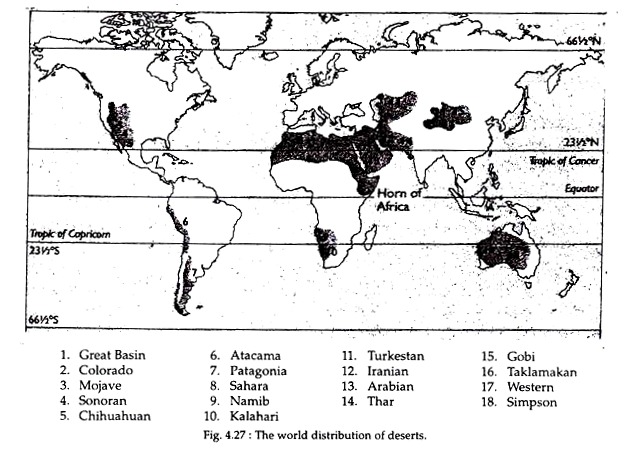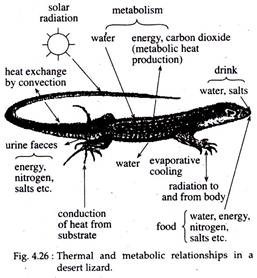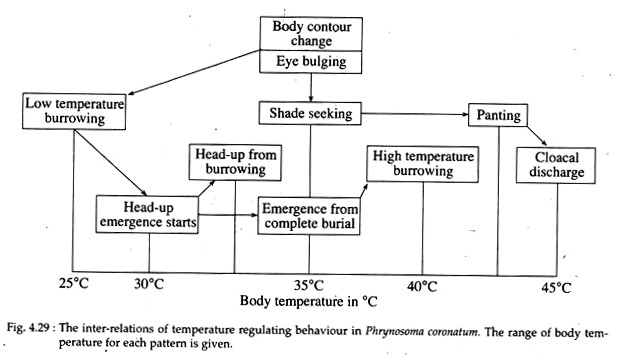In this article we will discus about the Desert Life:- 1. Definition of Desert 2. Disadvantages of the Desert Life 3. Origin.
Definition of Desert:
A desert can be defined as a vast stretch of drifting sands having rainless or rarely rainless climate (below 50 mm of rain per year) and where evaporation of water in excess of precipitation takes place involving rare vegetation and less animal population. The deserts are described today as arid zone, semiarid zone etc. on the basis of rainfall.
A list of different zones of desert on the basis of rainfall is given below:
Arid zone:
ADVERTISEMENTS:
The zone having less than 250 mm of rain per year.
Semi-arid zone:
This zone is having between 250 to 500 mm of rain per year.
Hyper-arid zone:
ADVERTISEMENTS:
This area is having less than 100 mm of rain per year. However, to define an area as arid to life system, climatologists have found it necessary to look at the relationship between rainfall and evaporation.
Origin and location of deserts on earth:
Almost all the deserts are located in the equatorial or in the tropical regions where the scorching sun rays fall perpendicularly (Fig. 4.25). Prolonged drought and famine when interrupted by flood is called periodic disaster. This type of disaster inevitably follows over exploitation of the fragile, unstable ecosystem of the semi-arid regions on the desert fringe.
Each of them adds to the relentless advance of desert conditions through aridity, which are endangered by human misuse of the environment. Arid zones are readily degraded to desert and aridity is clearly the primary cause of desert conditions. Approximately one third of the earth’s surface is classified as either arid or semi-arid zone (Fig. 4.27).
Features exhibited by desert:
Greater portion of desert is the sandy stretch. In the desert, nearly rainless climate persists resulting in continuous drought and low humidity. Desert consists comparatively of rare vegetation and animal population. Extremely hot temperature is the characteristic feature.
Disadvantages of the Desert Life:
(a) Water:
There is no trace of water except in the oasis, which is the only fertile spot. Such spots are distributed in a scattered fashion in the desert. To overcome the water crisis camels develop a large water intake capacity, when available.
(b) Temperature:
Intense heat is ardent during the day time while, on the contrary, extreme cold is noticed during night. The temperature ranges from 142°F-145°F.
(c) Humidity:
Humidity in the desert is very much low rendering a great disadvantage for the smooth animal life. Desert animals store large quantities of food as fat under the skin, which is believed to protect the animals from desiccation.
(d) Food:
ADVERTISEMENTS:
It is very much scarce in the desert and involves keen competition. Camels have the ability to store large quantities of food as fat in its hump. Its thick- skinned lips and mouth enable it to eat thorny xerophytic plants.
(e) Wind:
Wind blows in its dangerous fierce. One kind of ‘hot blast’ of wind is a terror to the desert life during day time.
Adaptations to Overcome the Disadvantages:
In order to overcome the above- mentioned disadvantages, the following modifications are noticed in desert living forms.
A. Moisture Getting:
It is the prime requisite of the desert forms and there are various processes to obtain moisture. A common practice to collect moisture is, from the juice of succulent plant sap or from blood of the prey. Most of the animals drink water in large amount when available. The permeability of reptile skin is variable and depends upon external conditions.
The skin is permeable when environment is saturated with water but is almost completely impermeable in dry weather. A spiny lizard of Australia, Moloch horridus can absorb water through the hygroscopic skin like a blotting paper. This water travels to the mouth by the capillary action and then swallowed.
B. Moisture Conservation:
(i) Reduction in Transpiration:
Amphibians generally exist on the desert fringe, where temporary or permanent water bodies are present, which are essential for their reproduction. In Australian frog Neobatrachus the rate of evaporation through skin is retarded, while the Rhodesian, Chiromantis xerampelina losses water very slowly. Reptilian skin is comparatively impermeable.
The presence of thick corneous stratum in the skin and small number of dermal gland ensures minimum water loss. Water loss through skin is far less significant in larger vertebrates like birds and mammals. The sweat glands are absent in rodents and other small mammals.
(ii) Respiratory Adaptation:
Respiratory membrane, permeable to oxygen and carbon dioxide are then also permeable to water vapour. Therefore, the air leaving any respiratory surface is also carrying water away from the body. Amphibians are apparently unable to control water loss through respiration, but reptiles have some capacity to do so.
Fluid secreted from nasal salt gland helps to cool and moisten the inhaled air in the desert iguana (Dipsosaurus dorsalis). As water is evaporated, this fluid becomes more concentrated and encrustations of crystalline salts are deposited around the nasal openings.
Tortoises can hold their inhaled air for long periods, especially at high ambient temperatures and are related with moisture conservation. Respiratory water loss in kangaroo-rat (Dipodomys merriami) and in other small desert mammals is reduced by means of a counter current heat exchange system in the nose.
(iii) Cellular Adaptations:
All cells of the body participate to overcome the water scarcity during travelling through desert. The water of all body cells comes out into the general stream of metabolism and meets the water requirement of the animal. It is proved that the lost weight of camel during travelling in the desert is regained only by drinking water.
The body cell can withstand the loss of 40% of water in camel and it can drink 10 gallons of water per second when thirsty. Formerly, it was believed that in camel, the first division of stomach or rumen, have water cells, which can store up the water for considerable number of days.
(iv) Excretory Adaptation:
Desert animals usually eliminate dry excreta in the form of solid uric acid crystals, which are extremely insoluble and thereby assist in conserving internal body water. Amphibians decrease the rate of urinary water loss and increases the rate at which water can be absorbed through the skin.
A neurohypophysial hormone, arginine vasotocin similar to ADH of mammals, mediates this process. They produce little urine and store urea in their bodies. In reptiles urinary wastes are eliminated as semi-solid mass, containing high proportion of uric acid with little water.
Urea is the principal excretory compound of mammals, while uric acid is that in birds and reptiles. The excretion of uric acid is associated with the possession of cleidoic or enclosed eggs.
Accumulation of salt in desert soil and saline water is another problem for desert life. Nasal salt gland of some desert reptiles and birds, including ostrich, excrete the extra salts from their body. The kidneys of desert mammals need to be efficient to produce urine with high concentrations of urea and salts simultaneously.
Camels can tolerate salt and/or bitter drinking water that would be poisonous to man and many other mammals. Their powerful kidneys can produce concentrated urine.
C. Defensive Mechanism:
Desert adapted animals develop various defensive mechanisms to overcome natural calamities. These are as follows:
(a) Defence against Environmental Hazards:
(i) Temperature:
Camelus bactrianus, i.e., bactrian camels of central Asia is shorter, sturdier and more hairy than its Arabian cousin Camelus dromedariaus and can withstand the subzero temperature of the winter months. Smaller mammals are often adapted to the desert climate by being nocturnal and avoiding excessive heat of the day.
The desert fox and desert hare of Sahara are adapted to the heat by having large ears, which give them greater cooling surface.
Desert rats, moles and shrews, burrow holes in the ground to get away from the excessive heat of the ground surface. Certain lizards practice ‘thermal dancing’ during the heat of the day, i.e., resting alternately on just two feet at a time to avoid total contact with the hot ground surface. Chameleons and some snakes change their skin colour in order to reflect more heat during the day.
Sometimes a special emergency, thermoregulatory mechanism can be seen in mammals. Jerboas (Faculus and Dipusi and kangaroo-rats (Dipodomys sp.) produce a copious flow of saliva in response to heat stress. This soaks the fur under the chin and throat, providing temporary defence when body temperature approaches lethal limits.
(ii) Defences Against Ubiquitous Sand:
Sands assail three important apertures like eyes, ears and nostrils. So .protection of these three apertures is needed.
Protection of Eyes:
In Typhlops, over hanging head-shields protect the eyes. In Agama and Phrynocephalus, margin of the eyelids are broad and ended into plates and scales. Large lower eyelid with transparent window protects the eyes in Mabuia. Lower eyelid is transformed into transparent cover, e.g., Ableplerus. In camel long eyelashes protect it from the effects of sand storms.
Protection of Nostrils:
The nose or rostrum is pointed or shovel-like. Sand swimmers dive head first into loose sand as if it was water. Nostrils are directed upward in digging species like, rats, moles etc., for rapid burrowing in the sand. Valves in some snakes protect nostrils.
Some snakes possess small pinhole-like nostrils. Nostrils are capable of being closed in camels. In saiga antelope (Saiga tatarica), the nostrils face backward so that sand is excluded during grazing.
Protrusion of Ear Openings:
External opening of ear is protected by fringe of scales in some reptiles. It may be abolished, e.g., Phrynocephalus. The long hair in camels protects the ear from sand storm.
Other Defence Mechanisms:
Lizards of the desert, whether they are ‘sand runner’ or ‘sand swimmer’ develop toes fringed with elongated scales, which widens the surface so as to press on the loose sand. Duck-like complete webbing is found in geckos (Palmatogecko sp.).
(b) Defence Against Other Animals:
(i) Colouration:
There is a close similarity in appearance between animals and the soil of the particular desert in which it is living. Most of the inhabitants of arid zones are either black or pale in colour, resembling their background. In many animals, the under surface of the body is very pale or even white. No green, grey, brown or red colour is seen in desert animals.
(ii) Mimicry:
To defend themselves from their predators, desert adapted animals mimic dangerous and poisonous forms.
(iii) Hard surface and Spines:
In horned toad and other spiny lizards, spines protect them from predators. Hard surface of the body investment is over looked as food by the predators.
(iv) Venom:
Almost all the desert reptiles are poisonous. Common red-ant is more poisonous than a rattlesnake in relation to its size. The bite of a rattlesnake can cause death within a few seconds. All desert spiders, scorpions and centipedes are poisonous.
D. Speed of Desert Animals:
Speed is a characteristic of desert dwellers because they have to travel far and wide for food and drink. Helical side winding is found in snakes, like Crotalus cerastes and horned vipers of the genus Cerastes. These snakes progress by lateral loops of the body. This adaptation is not only for production of high speed but also it halves the area of the body in contact with the hot surface.
Ostrich, camel and others are much speedy animals where body becomes slender in form and limbs become long. The camel has lost all except two of its toes and has increased the surface area of its feet by developing fleshy pads, which do not sink in the sand. The bipedal gait of jerboas and kangaroo-rats, like that of marsupial kangaroo and certain desert lizards, is an adaptation for speedy locomotion in open desert.
E. Development of Senses:
The senses of sight, hearing and smelling are highly developed. About 80% of desert mammals show hypertrophy or enlargement of bullae tympanicae. These are bony projections of the skull that encloses the middle ear. The bullae probably function as resonator, facilitating the perception of soil vibrations and acting as amplifiers, e.g., gerbils, cats and hedgehogs.
F. Behavioural Adaptation:
The hot day temperature forces most of the desert fauna to be nocturnal in habit and they pass the day in holes, burrows and other sheltered retreats. The scaly-tailed lizard (Uromastix acanthinurus) is active during the late part of the night and at dawn.
Desert snakes tend to be nocturnal while tortoises are diurnal. Small mammals such as kangaroo-rats, jerboas, gerbils and other rodents, fennec and kit foxes, only survive in the desert because they are nocturnal. Birds are active during day, except owls, nightjars and large mammals like camels, antelopes and wild asses, which cannot burrow. However, they seek the shade when the sun beats down most fiercely.
Origin of Desert life:
It is probable that all desert animals have been secondarily adapted. Most animals’ have their range greater than the desert limitation. However temporary migrants are common in the desert. Therefore, it is evident that the natural condition of desert is not suitable for animal life.
So perfect adaptation, does not occur. But ancient inhabitants like ostrich and camel show near perfect adaptation. Due to this reason it is expected that desert has originated during Miocene period, which corresponds to that of camel evolution.
Some examples of desert adapted vertebrates:
Class Amphibia:
Red spotted toad (Bufo punctatus), desert frog (Chiroleptes).
Class Reptilia:
Desert tortoise (Agama), gopher turtle (Gopherus), banded gecko (‘Coleonyx), spiny lizard (Sceloporus), fringed toed lizard (Uma), gila monster (Heloderma), Moloch horridus, blind snake (Typhlops, Leptotyphlops), boa (Lichanura), diamond rattle snake (Crotalus atrox).
Class Aves:
Ostrich (Struthio), hawks (Buteo), caracara, woodpecker (Centuriis, Dendrocops), great horned owl (Bubo), black throated sparrow (Amphispiza).
Class Mammalia:
Jerboas (Dipus, Jaculus), pocket mice (Perognathus), cactus mice (Peromyscus), pocket gopher (Geomys), sand cat (Felis margarita), desert fox (Vulpes corsac), gazelle (Gazella), oryx (Oryx), camel (Camelus), Asiatic wild ass (Equus hemionus).


